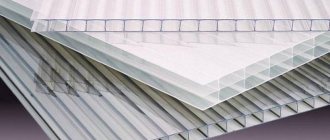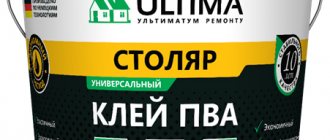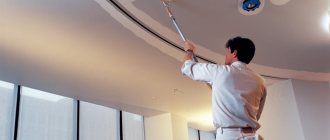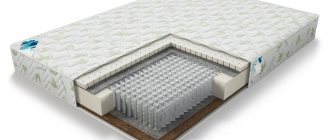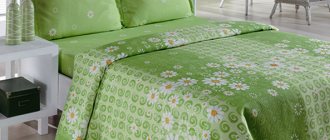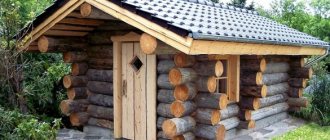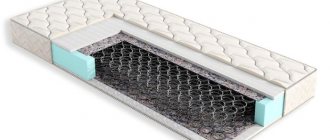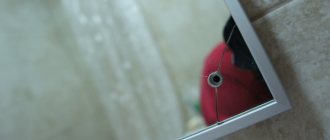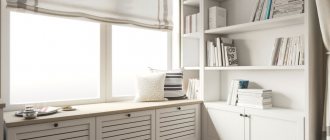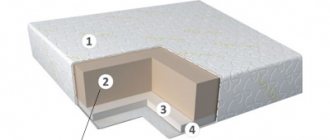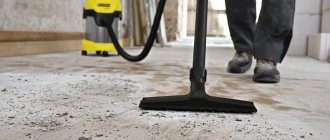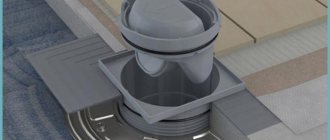No. 1. The main advantages of polycarbonate
Why did this relatively new material instantly captivate summer residents across the country and is rapidly displacing film and glass from their plots? The reasons for its popularity should be sought in the structural features of the material . Polycarbonate began to be produced on an industrial scale in the 60s of the last century; it was used in many areas of construction and industry, and material suitable for greenhouses appeared a little later at the suggestion of Israeli scientists.
To construct greenhouses, only cellular polycarbonate - the monolithic counterpart is heavier and does not have sufficient strength and thermal insulation qualities. The material consists of two or three plates parallel to each other, connected by jumpers. The latter play the role of stiffeners, and the space between them, filled with air, increases the thermal insulation qualities of the material. The leaf structure can be single-chamber, double-chamber, etc.
The main advantages of cellular polycarbonate for greenhouses:
- excellent transparency and ability to diffuse sunlight . Up to 92% of sunlight passes through colorless polycarbonate, which has a positive effect on the crops grown. Moreover, the material with a special protective film allows you to protect plants from harmful ultraviolet radiation;
- light weight . This parameter depends on the thickness of the sheet, but even the thickest material will weigh several times less than its glass counterpart, which reduces the load on the greenhouse frame;
- flexibility and plasticity . Cellular polycarbonate can be bent during installation, creating arched greenhouses;
- good mechanical strength . The impact will not tear the material like film or break into fragments like glass. The thicker the polycarbonate is chosen, the more difficult it will be to disrupt its integrity;
- excellent thermal insulation qualities due to the honeycomb structure of the material. Heating costs can be kept to a minimum. The soundproofing qualities of the material are also excellent - on average, it can reduce noise by 22 dB;
- resistance to temperature changes, winds, mold, fire.
The durability of high-quality polycarbonate exceeds 10 years, and conscientious manufacturers provide a guarantee of up to 15 years. Among the disadvantages of the material is instability to sunlight, like any plastic, but thanks to a special film coating, we managed to get rid of this disadvantage. Cellular polycarbonate has no other significant disadvantages, especially in comparison with other covering materials for greenhouses - the main thing is to buy high-quality material, and not a handicraft product.
Typically, cellular polycarbonate is produced in sheets with dimensions of 2.1 * 6 m and 2.1 * 12 m, less often 2.1 * 2 m, but the thickness can vary within a wider range (3.5-16 mm), and precisely from It largely depends on the basic parameters of the material.
Which polycarbonate is better for a greenhouse - cellular or monolithic?
To create an optimal temperature regime and maintain the required humidity in a greenhouse, polycarbonate profiles are ideal. However, the question may arise as to what type of PC is most suitable for creating a greenhouse.
To answer this, you should consider the parameters that determine the differences between these material options:
- With the same sheet thickness, a cellular PC has less weight, which is necessary for creating frameless structures and covering large areas.
- The cellular version is more energy efficient; it retains more heat due to the air layer between the sheets.
- The price of a cellular profile is lower than a monolithic one.
- The honeycomb profile allows for more diffused light, which has a positive effect on the development of plants and their productivity.
Based on this, experts recommend using cellular polycarbonate for the construction of greenhouses.
No. 2. Selecting the thickness of cellular polycarbonate
Thickness is a determining factor when choosing polycarbonate for a greenhouse. In this matter, it is important to take into account a lot of factors and choose a material that is not too thin, but not too thick: in the first case, strength decreases, in the second, light transmission deteriorates.
The main factors that influence the choice of polycarbonate thickness:
- climate of the region , especially the height of the snow cover and its weight, which determines the maximum load on the material;
- wind load in the region;
- frame material . A metal frame has better load-bearing capacity and can withstand higher loads than a wooden one;
- sheathing step . The closer the greenhouse frame elements are located to each other, the more durable the structure will be and the less thick the polycarbonate may be needed;
- seasonality of use . If the greenhouse will be used only in the autumn-spring period, then thinner polycarbonate can be chosen. For year-round greenhouses, the material chosen is significantly thicker, because it must withstand not only snow and wind, but also retain heat;
- type of construction If you plan to build an arched, dome or teardrop-shaped greenhouse, you need to think in advance whether it will be possible to bend the polycarbonate in a certain way. The thinner the material, the higher the bending radius.
How to choose the optimal thickness taking into account all these factors? To get the most accurate value, you can turn to professionals. The second option is to buy a ready-made greenhouse, the kit already includes polycarbonate of optimal thickness (the type of construction and climatic features are taken into account). An alternative solution is to try to choose the required polycarbonate yourself: complex calculations are not needed, since you can be guided by the practice of using the material, the main parameters of polycarbonate sheets of different thicknesses (in the table below) and data on the climate of the region, which is also easy to obtain on the Internet.
When considering different options for the thickness of polycarbonate for your greenhouse, it does not hurt
to follow the following recommendations :
- The most popular is polycarbonate with a thickness of 4 mm , but it should still be classified as an economical option. It makes sense to use it only in seasonal greenhouses, otherwise even a small sheathing step (0.5 m) will not save you from deformation under the weight of snow. Trying to save on polycarbonate, you will have to spend money on strengthening the frame, and in this case the structure only becomes more expensive. Do not forget that the frame does not allow light to pass through, and the more frequent the sheathing, the greater the shadow on the plants. Although this is not so scary for small household greenhouses, on a production scale this is already a serious minus, because reducing the amount of lighting by 1% reduces the yield by exactly the same amount;
- for most regions of the country, the optimal thickness of polycarbonate for the construction of spring-autumn greenhouses is called 6 mm , and for winter greenhouses - a single-chamber sheet 10 mm thick ;
- arched and dome greenhouses do not retain snow cover as much, which means that less stress is placed on the polycarbonate. However, it is unreasonable to choose too thin a material for arched greenhouses - during moments of sharp cold weather after a thaw, a layer of ice forms on the surface of the greenhouse, on which snow will stick well;
- polycarbonate that is too thick , because along with an increase in strength and thermal insulation qualities, the ability to transmit light decreases, and the weight also increases, so reinforcement of the structure will be necessary. 25-50% of the sun's rays pass through polycarbonate with a thickness of more than 10 mm, which means loss of yield and expenses for artificial lighting, so it is not recommended to use material thicker than 10 mm in private greenhouses .
If the greenhouse is being built on your own, then it is better to decide on the thickness of the polycarbonate at the design stage.
What is polycarbonate for greenhouses?
This is a thermoplastic polymer, or, in other words, polymer plastic, which has the form of granules and remains in this form until processing.
It is molded in several ways:
- injection molding - for the production of products;
- blow molding - to create three-dimensional vessels;
- extrusion - for profiles and films;
- melt spinning of fibers.
Find out how to make a greenhouse with a polycarbonate house.
The substance contains:
- carbonic acid;
- diatomic phenol;
- water;
- dyes;
- solvents.
Polycarbonate is created based on bisphenol A as a result of synthesis by condensation of phenol and acetone. In its pure form, the product is transparent, colorless or yellowish, but dyes are often used in production to produce colored products. For convenience, the term “polycarbonate” is often abbreviated to the abbreviation PC, or in the English version - PC.
Cellular polycarbonate sheets are successfully used for glazing:
- greenhouses;
- verandas, gazebos, loggias;
- swimming pools;
- roofs of sports facilities.
This choice of material helps to save energy resources and reduces the cost of heating greenhouses.
Read more about how to build a winter greenhouse with your own hands.
In addition, it is used to make:
- stops and shelters;
- acoustic screens;
- impact-resistant doors and windows.
No. 3. Honeycomb geometry and polycarbonate strength
The partitions inside polycarbonate form honeycombs, the shape of which significantly affects the strength of the material and its load-bearing capacity. The most common options:
- rectangular honeycomb is the most common material. The load-bearing capacity is not very high, but light transmission remains at a high level. This polycarbonate is recommended for use in greenhouses where artificial lighting is not provided;
- square honeycombs make the material more durable and suitable for the construction of medium-load greenhouses;
- hexagonal honeycomb They allow you to achieve the highest strength, but greatly reduce the level of light transmission, so such polycarbonate is rarely used for the construction of greenhouses, and if used, it requires the mandatory arrangement of artificial lighting.
How to choose material
So, you want a greenhouse, no matter what kind - stationary or prefabricated. The most correct decision would be to order it directly from the company engaged in the manufacture and installation of these very structures. And they simply must know what thickness of polycarbonate is best to use for a greenhouse. By doing this, you will not only be able to avoid mistakes during construction, but also place all responsibility for the quality of the material on the manufacturer.
Keep in mind that the company must provide a guarantee both for the polycarbonate itself and for the greenhouse in general. The longer the warranty period of the structure, the stronger and more restful your sleep. If you listened to the advice, then you don’t have to read any further. All you have to do is harvest the crops grown in this greenhouse, and if any defects are detected, call the manufacturer and demand their immediate elimination. If, for some economic reasons or thanks to your hard work, you have decided to undertake difficult independent construction, welcome to the store.
First of all, when choosing polycarbonate, ask to see all available documents. If there are none, it’s a fake, we don’t buy it. If there are not enough fasteners or different colors of joining and end strips, we will not accept them. We observe swelling or damage to the protective film - to the side. There are no markings on the top and ends of the sheets - let them keep them. Don’t be afraid to ask the sellers questions; ask a department consultant what thickness of polycarbonate is best for a greenhouse. At the same time, remember that their job is to sell, and then you have to suffer with low-quality goods.
No. 4. Polycarbonate color
Having decided on the required thickness of the material and coming to the store, you can find that polycarbonate is available in a whole range of colors. Which one is better? Of course, transparent, because it allows you to provide plants with lighting that is as close to natural as possible, and besides, it allows maximum sunlight to pass through. Summer residents who want to get maximum yield and not spend money on additional lighting choose transparent polycarbonate .
Painted polycarbonate is not able to provide plants with a sufficient level of light: bronze, opal, yellow and green sheets transmit only 40-60% of the light, so it is difficult to talk about normal yields. Some gardeners choose polycarbonate in red and orange shades, citing the fact that the orange and red range of solar radiation is most beneficial for plant growth. It’s hard to argue with this statement if you remember the school course in biology and physics, but there is one “but”: fewer useful rays will pass through, and their quantity will not be enough for the normal growth of most crops, so the best choice is transparent polycarbonate .
Disadvantages of polycarbonate
The material also has disadvantages, although in small quantities. Among the main disadvantages:
Low abrasive resistance. The material is scratch resistant. Caring for it requires a delicate approach. Do not use detergents with grains or abrasive sponges, or fabrics that are too rough.
Perceptible thermal expansion. High and low temperatures can cause the material to expand or contract. This feature must be taken into account during the installation of structures.
Destruction under the influence of UV. Polycarbonate itself actually deteriorates when exposed to sunlight. But manufacturers eliminated this disadvantage by adding a special film to the structure that protects against aggressive UV rays.
Small disadvantages can easily be compensated for by proper handling of the material. Correct care and installation almost completely reduce the small negative nuances of polycarbonate to zero.
No. 5. Protection of polycarbonate from ultraviolet rays
Reading about the positive properties of polycarbonate, you might think that this is an ideal material with no disadvantages. Naturally this is not the case. The main disadvantage is the tendency to destruction under ultraviolet rays , which trigger the process of photoelectric destruction on the surface, leading to the formation of small cracks. Gradually they grow, causing the panels to become brittle and destroyed. That is why the material needs additional protection. Hard ultraviolet radiation (in the spectrum up to 280 nm) is harmful to plants, so the protective coating protects not only polycarbonate, but also the crops being grown.
Responsible manufacturers use a special film , which is applied using the co-extrusion method , so it does not peel off during operation. Such high-quality polycarbonate can easily last about 10 years. There is a material on sale on which a protective film is applied on both sides, but its use does not make sense for greenhouses. When installing sheets, it is important to pay attention to the markings and install the polycarbonate with the protective layer facing outward.
Unscrupulous manufacturers (often Chinese) produce polycarbonate without any protective coating at all, or they make it symbolic. This means that instead of using a film, simple additives are introduced into the mass, which should protect the material from solar radiation. Such polycarbonate “lives” for a maximum of 2-3 years, then it will have to be replaced, and this is again a waste. When buying initially cheap material, you should think three times about the consequences. Information about the presence of a protective coating must be indicated on the packaging and in the accompanying documentation, since it is impossible to see it externally (thickness is 0.0035-0.006 mm).
Properties of polycarbonate for greenhouses
This synthetic material has the following characteristics:
- high light transmission;
- transparency ~90%;
- good thermal insulation;
- good gas and vapor permeability;
- light weight - material density is 1.2 g/cm³;
- good flexibility, can be used for arched structures;
- low cost;
- Duration of operation - more than 10 years without loss of properties;
- fire-resistant, self-extinguishing;
- durable, not inferior to aluminum, at the same time, the reinforced, multi-layer monolithic appearance can protect against a shot from a firearm;
- this is an eco-friendly material - it is safe, non-toxic, meets FDA and EC requirements, can come into contact with food;
- does not lose its properties at high temperatures, up to +60°C, and with significant temperature fluctuations;
- retains ultraviolet rays thanks to a special protective agent included in its composition;
- does not require protection from mechanical damage.
Polycarbonate becomes brittle only at very low temperatures - below –50°C, which do not occur during operation.
Important! When exposed to high temperatures, the material can expand up to 4 mm, which is important to consider when creating a project and using it in construction.
You should know that this type of plastic is not resistant to the following chemicals:
- ethanol;
- petrol;
- ammonia;
- kerosene;
- solvents and varnishes.
With prolonged aggressive exposure, it can partially soften, dissolve or absorb the substance. Cracks may appear, especially if the PC is under stress or strain. Based on this, it is worth remembering that caring for polycarbonate should be carried out with products that do not contain the above components.
No. 6. What does the prefix “light” mean in polycarbonate labeling?
Cunning manufacturers and sellers sometimes mislead buyers by using the designation “light” in the labeling. Choosing such polycarbonate for a greenhouse means overpaying and getting a material with reduced strength. Often thinner polycarbonate is sold under the lightweight version, but the price remains standard. Instead of 4 mm, it can feed material with a thickness of 3.5 mm, instead of 6 mm - 5.5, 8 mm - 7.5 mm, etc. It seems that the difference is small, but with a decrease in thickness (and therefore strength and durability), the price does not fall - not the most profitable purchase. In addition, it is not recommended to use polycarbonate with a thickness of less than 4 mm for a greenhouse.
Choosing polycarbonate
How to choose the right polycarbonate for a greenhouse, which will meet all the necessary requirements and become optimal? Everything is very simple.
Step 1. Assess the climatic conditions of the region in which you live. Think about how often strong winds blow in your area, how much snow falls, and how many days a year the weather is warm.
This is what happens when loads are poorly calculated
Step 2. Consider the shape and dimensions of the structure you want to build on your summer cottage. Remember that for arched greenhouses or structures with steep roof slopes, thinner polycarbonate can be used.
Polycarbonate greenhouse frame
Step 3. Assess the lifespan of the greenhouse. Will it be used all year round? Or are you planning to grow vegetables in it only in the summer?
Small summer greenhouse made of polycarbonate
Step 4. Think about what crops you will grow in the greenhouse. Some need a lot of light and warmth, while others need a little light. The choice of polycarbonate, both in terms of thickness and ability to retain heat, will also depend on this.
Country greenhouse
Step 5: When you go to the store, be prepared to take some measurements yourself. Careless sellers may sell you thinner material than what you need. Take a ruler with you.
Polycarbonate thickness
Table of recommended spans of load-bearing beams for profiled polycarbonate sheets
Step 6. Carefully inspect the sheet you have chosen: it must be intact, have a protective film, the stiffeners must be smooth (not bent or broken).
Polycarbonate sheets must be intact, with the protective film intact
Step 7. Ask the seller for product certificates. Each polycarbonate must have accompanying documents confirming its quality.
Step 8: Check to see if there is a mark on the protective film indicating that the sheet has UV protection.
The protective film must have marks indicating UV protection
On a note! There is no point in buying polycarbonate without this protection - it will be a waste of money, since a greenhouse made from it will not last long.
How to distinguish high-quality polycarbonate from a fake
If you are afraid of making a mistake with the choice of polycarbonate, then contact specialists who will accurately calculate the required density and thickness of the material in accordance with the stated requirements. True, their services are not cheap.
Polycarbonate greenhouse dimensions, drawing
In this article you will find many different drawings of a polycarbonate greenhouse with dimensions! We also recommend reading the article on how to make a greenhouse from window frames with your own hands.
Video - Choosing polycarbonate
No. 7. Size of polycarbonate sheets and features of working with the material
With a width of 2.1 m, polycarbonate sheets are sold mainly in lengths of 6 and 12 m, a deviation of 3 mm in width and 10 mm in length is allowed. The accumulated experience of many summer residents allows us to formulate a number of tips on the most rational use of material:
- if the greenhouse has an arched shape, then the length of the arcs of the power structures is recommended to be 6 and 12 m in order to avoid transverse joints;
- it is better to make the distance between the load-bearing elements of the frame such that the joints of the sheets fall on the profile, which increases the strength of the structure;
- When constructing gable greenhouses, it is better to make the walls and roof so that the polycarbonate sheets are divided without residue.
Polycarbonate increases in size in hot weather, and decreases in cold weather. Every degree increase in temperature causes the material to expand by 0.065 mm/m. This should be taken into account when attaching polycarbonate to the frame, leaving small gaps between the sheet of material and the supporting structure.
Caring for polycarbonate is as simple as possible: it needs to be washed several times a year, you can use a weak soap solution, but not aggressive agents. The main goal of such care is to maintain a high level of transparency.
What types are there and how are they different?
Monolithic and cellular, that is, cellular, polycarbonate are used in construction.
Monolithic is a transparent plate resembling glass, but this material is much stronger and has greater light transmittance. Monolithic is used mainly on an industrial scale.
Cellular polycarbonate looks like two sheets connected by jumpers. It turns out that it consists of many cells. The honeycomb product is widely used for the construction of canopies, roofs and other structures. Gardeners appreciate its qualities and willingly use it to equip greenhouse frames. A polycarbonate greenhouse is an excellent place for seedlings, because this material protects plants well from wind, frost, precipitation, and ultraviolet radiation. It scatters direct sunlight, thereby preventing the delicate leaves from being burned and evenly distributing the light inside the greenhouse, serving for a long time.
Polycarbonate honeycomb
Polycarbonate sheets are composed of so-called honeycombs. They are rectangular, square, hexagonal. The type of honeycomb the sheets are made of affects the strength of the latter. So, the simplest honeycombs are rectangular. They transmit light perfectly, so they are ideal for simple greenhouses of conventional design. True, rectangular honeycombs cannot boast of good load-bearing abilities, but they will withstand the season without problems.
More durable sheets are composed of square honeycombs. This material can be used for greenhouses that have lamp lighting. Such polycarbonate sheets will withstand lighting fixtures hanging from the ceiling.
The strongest sheets are made from hexagonal honeycombs. They can be used from season to season, since they are practically not afraid of either weight or mechanical impact, but they transmit little light, so greenhouses must be equipped with lamps to illuminate the plants.
Strength
The polymer material is quite durable - with one blow, like glass, it cannot be broken. Strength is given by the thickness of the sheet. The most durable ones have a thickness of more than 10 mm. They are used for roofing work. An economical option with a thickness of 4 mm is more susceptible to mechanical stress and cannot withstand heavy weight. This material is usually used for lightweight structures. However, even with a small thickness, polymer is more in demand than glass. Polycarbonate (due to its structure) is able to withstand external influences. Therefore, it is considered one of the best materials for glazing greenhouses.
Color
Construction stores offer sheets of various colors. But for greenhouses it is better to choose transparent ones, not colored ones, so that the plants receive enough light. It would seem, why not choose red polycarbonate for the greenhouse roof? After all, gardeners use red lamps to stimulate the growth and development of seedlings. However, in this case, choosing a colored material rather than a transparent one will not improve the development of plants at all, but will only deprive them of the necessary light.
UV protection
Plants protected by polycarbonate are saved from merciless ultraviolet rays, but the protector itself cannot withstand ultraviolet radiation for long. Gradually, cracks appear on the plates, which grow over time, and eventually the broken sheets collapse.
To make the building material stronger, manufacturers cover polymer sheets with a protective film. Such a shield will last ten years.
For greenhouses, you need to purchase polycarbonate with a protective layer. In order not to make a mistake when choosing a material, you need to pay attention to the information in the instructions that manufacturers supply the product with. The characteristics of the product are also indicated on the packaging, which must be examined.
Sheet size
Standard sheet sizes: length 6 and 12 meters – width 2.1 m.
Monolithic polycarbonate is usually produced in sheets: 6.5 m long and 2.1 m wide, 12 m long and 2.1 m wide.
Price
Prices depend on the thickness of the material, which means its strength. So, for a sheet of cellular polycarbonate 6 m long with a thickness of 4 mm you need to pay within 1.5 thousand rubles. For a product of the same quality, but 12 m long, you need to pay about 3 thousand rubles. For a sheet 6 mm thick you need to pay about 3.5 thousand rubles, for 12 m - about 5 thousand rubles. A sheet 8 mm thick costs on average about 6 thousand rubles, a sheet 12 m long costs almost twice as much. A 6 m long polycarbonate sheet “light” costs about 2 thousand rubles.
What role does the thickness of polycarbonate play for a greenhouse?
Manufacturers recommend choosing polycarbonate taking into account the structures for which it will be used. After all, strength and impact resistance directly depend on the thickness of the sheet.
Thus, sheets with a thickness of 4 mm are produced for lightweight structures, for example, display windows. If such material is used for greenhouses, then in regions where the climate is mild, there is no heavy rainfall and no wind. Sheets with a thickness of 6 mm are ideal for small greenhouses, stained glass windows, canopies, and other architectural designs. Sheets with a thickness of 8 mm are used for the production of large greenhouses and roofing work. Polycarbonate 10 mm thick is needed for vertical glazing. Sheets with a thickness of 16 mm are used for roofing work over large areas. Sheets with a thickness of 20 mm and 25 mm are used to glaze industrial and large objects.
Thus, for gardening, options with a thickness of 6 and 8 mm are best suited; this material will cope well with the tasks set: it will protect the plants from bad weather, let in enough light for the plants to develop well, and maintain the desired climate in the greenhouse.
How to fertilize the soil in a greenhouse in the spring before planting
Criterias of choice
The size of polycarbonate sheet for greenhouses is an important parameter. During installation, it is advisable that the joints fall on the load-bearing structural elements, both for gable and arched greenhouse models. If cutting is necessary, you need to pay attention to the distance between the stiffeners.
Table of the thickness and width of polycarbonate sheets for greenhouses, which is best to use for arched structures
Moreover, the length of the sheet can vary significantly among different manufacturers. For arched structures, the optimal sheet length is 10 - 12 m. For pitched structures, which have a large number of small areas of “glazing”, it is better to take elements of medium area, since it is more convenient to work with them during cutting.
Color, according to manufacturers, has no particular effect on light transmission. Which polycarbonate is better for a greenhouse? According to reviews on construction and agricultural forums, the use of pigmented polycarbonate for a greenhouse is justified only if increased aesthetic requirements are imposed on the structure.
Note: The internal structure affects the possibility of use no less than, for example, the thickness of polycarbonate for a winter greenhouse. Pay attention to the bending radius. This must be taken into account if arched greenhouses with a small radius are to be covered.
Polycarbonate: what, why and why
First, you need to understand what polycarbonate actually is. By itself, it is a colorless solid polymer plastic, which is made from polycarbonate granules. It has a lot of positive properties, which is why it has become one of the most popular materials used in the construction of greenhouses.
Multi-colored polycarbonate granules
The main advantages of polycarbonate are that it:
- not afraid of frost;
- has high strength;
- easy;
- plastic;
- thermoplastic;
- does not conduct electricity;
- optically transparent (which is very important for plants living in a greenhouse);
- can be recycled;
- durable.
All these properties of polycarbonate appeared due to the special structure of the macromolecules of which it consists.
Technical properties of polycarbonate honeycomb sheets
On a note! Polycarbonate is thermoplastic. This means that even after repeated melting, when it hardens, it again restores its properties.
Cellular polycarbonate device
Polycarbonate can be monolithic or cellular. The first option is a dense sheet, similar to glass, only much lighter, without voids inside.
Monolithic polycarbonate
Prices for monolithic polycarbonate
monolithic polycarbonate
And the second type is a material that is a sheet with a visible internal structure. This is a multilayer structure with many small jumpers, the so-called stiffeners.
Cellular Polycarbonate Sheet
Prices for cellular polycarbonate
cellular polycarbonate
Let us consider the properties of this material in more detail. Knowing everything about them, you will immediately understand why polycarbonate is so often used to create greenhouses.
- Lightness . Monolithic polycarbonate is very light - it is 2 times lighter than glass. And cellular polycarbonate has even less weight - it is 6 times lighter than the same glass. It is due to this that it is possible to create large, but at the same time lightweight structures from the material, and due to the fact that it is possible to install a simpler and narrower frame, the light-transmitting surface also increases, which is especially important for greenhouses. By the way, due to the simplification of the base, there is a reduction in the cost of the entire structure. Lightness also ensures ease of installation - the work can be done on your own without the use of complex lifting devices.
Weight of cellular polycarbonate
- Good thermal insulation . Thanks to the air in the voids inside the cellular polycarbonate sheet, the material retains heat much better than ordinary glass.
- Durability . Due to the special structure of the molecules that make up polycarbonate, it is a very durable material - if you compare it with glass, it is not afraid of impacts, and can withstand other physical impacts - for example, the weight of snow or strong wind. By the way, even if a polycarbonate sheet breaks for some reason, its fragments will not fly in all directions, which cannot be said about glass. However, they do not pose such a danger.
- Transparency . Monolithic polycarbonate transmits up to 90% of light - this figure is greater than that of glass. Cellular polycarbonate is not transparent to that extent, but, nevertheless, the thin version of the material transmits up to 85% of light.
- Flexibility . Polycarbonate is very flexible and, thanks to this property, it is convenient to cover structures with arches. It is due to this, and also thanks to convenient profiles, that polycarbonate is very easy to install.
- Heat resistance . Polycarbonate can withstand temperatures from -40 to +120 degrees.
- Easy to care for . This material can be simply washed with water and a cloth, even without the use of cleaning agents. If their use is necessary, then you can use any, except those containing ammonia - this is the only substance that polycarbonate does not like.
- Durability . Good polycarbonate can last for decades.
Assessment of the priority properties of sheet plastics and glass (using a 5-point system) when used as structural materials in facilities. The values are given for sheet materials with a thickness of 4 mm. PMMA—polymethyl methacrylate; PVC-polyvinyl chloride; PET-G - polyethylene terephthalate glycol; PS-polystyrene; UPS - impact-resistant polystyrene; PC - polycarbonate.
Comparison of the properties of polycarbonate, sheet plastics and glass
Washing a polycarbonate greenhouse
What density of carbonate is best to use for a greenhouse?
Photo: https://nashgazon.com/
The density of polycarbonate is one of the most important properties that you need to pay attention to when purchasing. In this case we are talking about the ratio of weight to volume of the material. And since the density can be completely different for the same thickness of different polycarbonate sheets, this will greatly affect the other parameters of the material. Thus, a lightweight product sheet with a density of 0.52 kg/m3 has thinner walls and internal stiffeners than polycarbonate with a density of 0.72. And since the partitions are thinner, the material loses its rigidity and strength, becoming quite fragile. Accordingly, it is susceptible to damage, breaks easily, and loses impact resistance. Thus, the higher the density of polycarbonate, the better, more reliable and longer the material will serve. This means that priorities should be given to products with a high density index. Again, based on the goals pursued and operating conditions.
Cutting polycarbonate
Cutting polycarbonate for a greenhouse can be done with a plasterboard mounting knife, a hacksaw, a grinder or a doze with a special toothed attachment. The process is carried out in the following sequence:
The front and back protective film remains on the sheets until the very end of cutting and installation. It is advisable to remove it after assembling the entire structure.
The resulting sawdust must be blown out of the internal channels.
You need to cut along the voids, exactly in the middle.
Important! Tolerances of 2-3 mm must be maintained to compensate for thermal deformation of the material.
The most difficult thing is to carry out curved cutting of the end and door elements. To do this, you need to make marks on a polycarbonate sheet according to the proposed diagram. Before this, you need to calculate the actual dimensions of the structure and transfer them to the sheet.
Cutting polycarbonate for the ends of the greenhouse, diagram on a sheet measuring 2.1x6m
The procedure for cutting polycarbonate for a greenhouse can be seen in more detail in the video:
